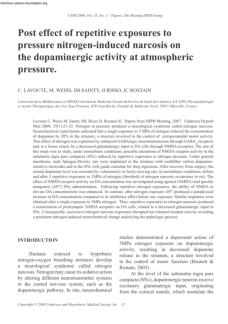Scientific papers 2008









Authors: Simon J, Mitchell & David J Doolette
Inner ear decompression sickness is linked to right-to-left
shunts. This relationship is puzzling since people often do
not show brain symptoms. It may be because gas bubbles
in the inner ear take longer to leave after diving, allowing
them to grow. Models show that the inner ear has a
longer nitrogen washout time than the brain, supporting
its potential role in decompression sickness in affected
divers.
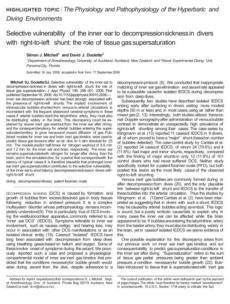


Authors: R. E. Moon, A. D. Cherry, B. W. Stolp, E. M.
Camporesi
Diving-related pulmonary effects are due mostly to
increased gas density, immersion-related increase in
pulmonary blood volume, and (usually) a higher inspired
PO2. Higher gas density produces an increase in airways
resistance and work of breathing and a reduced
maximum breathing capacity. An additional mechanical
load is due to immersion, which can impose a static
transrespiratory pressure load as well as a decrease in
pulmonary compliance.
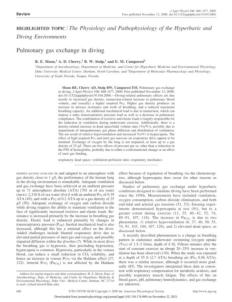

Authors: Nico A.M. Schellart, Jan-JaapBrandt Corstius,
Peter Germonpré, and Wouter Sterk.
It is claimed that performing a “deep stop,” a stop at about
half of the maximal diving depth (MDD), can reduce the
amount of detectable precordial bubbles after the dive
and may thus diminish the risk of decompression sickness.
In order to ascertain whether this reduction is caused by
the deep stop or by a prolonged decompression time, the
team wanted to test the “deep stop” theory without
increasing the total decompression time.


Authors: Zeljko Dujic, Zoran Valic, Alf O. Brubakk.
Exercising before, during, or after diving is proscribed
because of the assumption that it would increase the
incidence of decompression sickness. The authors say that
their findings show that exercise performed in a timely
fashion before diving or during decompression will
reduce the number of venous gas bubbles formed.
Exercise after diving did not increase the number of
bubbles. The authors also say that nitric oxide seems to
play a protective role.
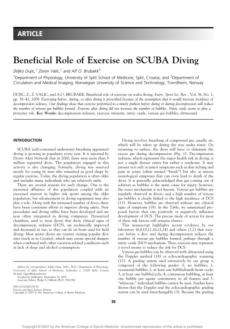

Author: Keith A. Gault (US Navy)
Generation III Air Navy Dive Computers (AIR III) were used
to record 315 ship husbandry dives conducted by divers
breathing air at the Puget Sound Naval Shipyard from
November 2007 to January 2008. For each profile,
decompression status was assessed from the air tables in
Rev. 6 of the U.S. Navy Diving Manual, and from the AIR
Ills, thirty-five dives were repetitive dives (within 12 hours
of previous exposure), so 280 are distinct profiles for
analysis.
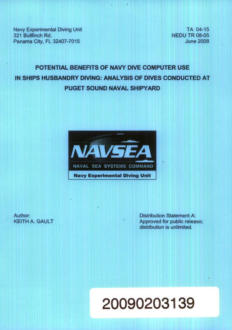

Authors:
D Levett, I L Milar
Exposure to the underwater environment for
recreationalor occupational purposes is increasing.
Approximately 7 million divers are active worldwide and
500 000 more are training every year. Diving related
illnesses are consequently an increasingly common clinical
problem with over 1000 cases of decompression illness
reported annually in the USA alone.
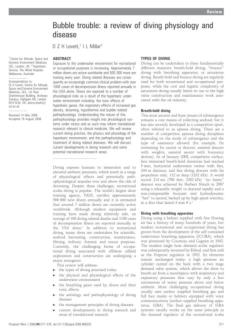

Authors: E Gempp, J E Blatteau, J-M Pontier, C Balestra, &
P Louge.
To investigate whether pre-hydration 90 minutes before a
dive could decrease bubble formation and evaluate the
consequent adjustments in plasma volume (PV), water
balance, and plasma surface tension (ST), eight military
divers participated in a crossover trial of pre-dive hydration
using saline–glucose beverage, and a controlled dive with
no pre-hydration. Drink volume was 1300 ml and drinking
time was 50–60 min. The diving protocol consisted of an
open sea field air dive at 30 msw depth for 30 min
followed by a 9 min stop at three msw. Haemodynamic
parameters, body weight measurements, urine volume,
and blood samples were taken before/after fluid intake
and after the dive. Decompression bubbles were
examined by a precordial pulsed Doppler.
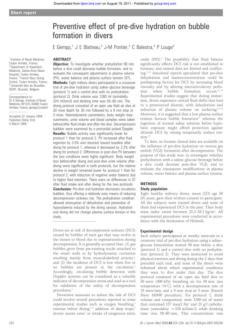

Author: Stephen R. Thom
This review aims to outline advances addressing the role
that reactive species of oxygen and nitrogen play in
the therapeutic mechanisms of hyperbaric oxygen.
The study will be organized around major
categories of problems or processes where
controlled clinical trials have demonstrated clinical
efficacy for hyperbaric oxygen therapy. Reactive
species are now recognized to play a major role in
cell signal
transduction cascades, and the discussion will focus on
how hyperbaric oxygen acts through these pathways to
mediate wound healing and ameliorate postischemic and
inflammatory injuries.


Authors: Jean- Éric Blatteau, Emmanuel Gempp,
Costantino Balestra, Tony Mets, and Peter Germonpre.
This study investigated the influence of a far infrared-ray
dry sauna-induced heat exposure before a simulated dive
on bubble formation, and examined the concomitant
adjustments in hemodynamic parameters.


Authors: T. Randsøe, T. M. Kvist, and O. Hyldegaard
The authors of this report visually followed the in vivo
changes of micro air bubbles injected into adipose tissue
of anesthetized rats at 101.3 kPa (sea level), after which
they were decompressed from 101.3 kPa to and held at
25 kPa (10,350 m), during breathing of oxygen or a heliox
(34:66) mixture (34% helium and 66% oxygen).
Furthermore, bubbles were studied during oxygen
breathing preceded by a 3-h period of preoxygenation to
eliminate tissue nitrogen before decompression.

Authors: Ian Millar & Peter G Mouldey
This small study records the various contaminants that can
be found in compressed gas and the control measures to
implement to eliminate them.


Authors: Leigh A. Madden, Gerard Laden
In this study, the authors hypothesize that gas bubbles are
not the causative agent in the progression of DCI, rather
an exacerbating factor. Endothelial dysfunction caused by
a temporary loss of haemostasis due to increased total
oxidant status is postulated to be the cause in this at-depth
endothelial dysfunction hypothesis.
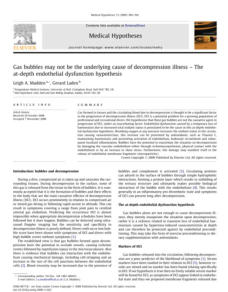

Authors: Melissa K. Brown & David C. Willms
The medical use of helium-oxygen mixture (heliox) was
first described as a therapy for asthma and airway
obstructions in 1934 by Barach. Heliox applications have
expanded from airway obstruction and asthma to
bronchiolitis and chronic obstructive pulmonary disease
(COPD). Helium is an odorless, colorless, non-combustible,
biologically inert gas, and has other physical properties
that make it medically useful when mixed with oxygen.
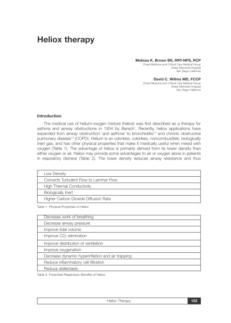

Authors: Nico A.M. Schellart , Jan-Jaap Brandt Corstiu,
Peter Germonpré, & Wouter Sterk
It is claimed that performing a “deep stop” a stop at about
half of maximal diving depth (MDD), can reduce the
amount of detectable precordial bubbles after the dive
and may thus diminish the risk of decompression sickness.
To ascertain whether this reduction is caused by the deep
stop or by a prolonged decompression time, the authors
tested the “ deep stop ” theory without increasing the
total decompression time.

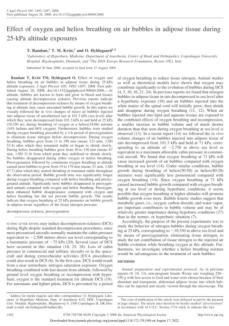

Authors: F. K. Butler, C. Hagan, H. Murphy-Lavoie
This paper is a review of HBOT (Hyperbaric Oxygen
Treatment) for ocular indications.
Because some ocular disorders require rapid
administration of HBOT to restore vision, patients with
acute vision loss should be considered emergent when
they present. Visual acuity should be checked
immediately.
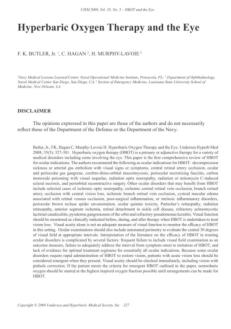

Author: Valerie Flook
This report derives from and clarifies those published by
Unimed Scientific Ltd in 2002 and 2003 for “Well Ops UK
Ltd”. The major part of the work was carried out for UK
Health and Safety Executive, and the report is available
from the HSE web site as research report number RR244.
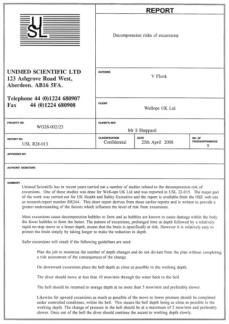

Authors: Akin Savas Toklu, Sefika Korpinar, Mustafa Erelel,
Gunalp Uzun, Senol Yildiz
Air cysts or blebs in the lungs may predispose pulmonary
barotrauma (PBT) by causing air trapping when there is a
change in environmental pressure. The changes in the
environmental pressure are also seen during hyperbaric
oxygen treatments (HBOT).
The aim of this study was to determine how patients were
evaluated for pulmonary blebs or bullae, and PBT
prevalence in different HBOT centers.
HBOT centers were asked to participate in this study, and
a questionnaire was sent via e-mail, to which 98 centers
responded.
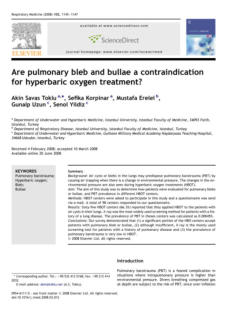

Authors:
Tiina M. Makinen, Raija Juvonen, Jari Jokelainen, Terttu H.
Harju, Ari Peitso, Aini Bloigu, Sylvi Silvennoinen-Kassinen,
Maija Leinonen, Juhani Hassi
This study examined whether the development of acute
respiratory tract infections (RTIs) is potentiated by cold
exposure and lowered humidity in a northern population.
It should be linked to the humidity level in the diving
breathing gasses.
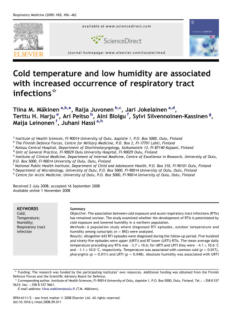

Publisher: Undersea and Hyperbaric Medical Society
This document is the proceedings of a workshop held at
the Salt Palace Convention Center in Salt Lake City, Utah,
USA, in June 2008.
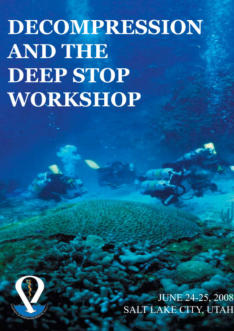

Click on the octopus
to return to the top
of the page

Auhor: Steve Selvin
This practical guide to survival data analysis is designed for
readers with a basic understanding of statistics. It explains
the rationale behind the analytic methods and shows
how to effectively analyze and interpret epidemiological
and medical survival data using modern computer
systems.


Authors: Peter Lindholm, & Claes EG Lundgren
This overview covers the physiological reactions,
limitations, and pathophysiological mechanisms linked to
breath-hold diving. Despite approaching physiological
limits, as evidenced by post-dive pulmonary issues, the
pursuit of performance enhancement continues. The
discussion includes the diving response of the
cardiovascular system, respiratory challenges, mechanisms
related to hypoxia and loss of consciousness, and the risks
of decompression sickness and narcosis due to high
nitrogen pressure in the lungs.


Authors: Azriel Perel, & Jean-Jacques Rouby
The intent of the text is to discuss and critique recent
findings on the effects of positive end-expiratory pressure
(PEEP) on pulmonary recruitability in patients with adult
respiratory distress syndrome (ARDS). The author
references a study by Thille et al. and an accompanying
editorial by Rouby, highlighting that Thille et al. concluded
that PEEP levels should not be determined based on the
cause of ARDS. The author contrasts this with their own
older studies, which suggest that the effectiveness of PEEP
does depend on the etiology of ARDS, particularly noting
differences in response between patients with and
without sepsis.
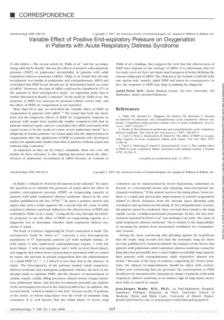

Authors:
Sarah Nolan, Rachel Dixon, Keith Norman, Paul Hellewell,
and Victoria Ridger
The study shows that nitric oxide can regulate neutrophil
migration by controlling the formation of L-selectin (Cell
adhesion molecules that facilitate the leukocyte migration
to sites of inflammation or injury) and P-selectin
glycoprotein ligand-1 (PSGL-1), a cell adhesion molecule,
enabling the tethering and rolling of leukocytes on the
endothelial cells during the inflammatory response. These
findings offer insights into nitric oxide's role in
inflammation and neutrophil migration.
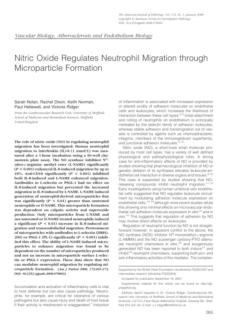

Authors:
Tami A. Martino, Gavin Y. Oudit, Andrew M. Herzenberg,
Nazneen Tata, Margaret M. Koletar, Golam M. Kabir,
Denise D. Belsham, Peter H. Backx, Martin R. Ralph, and
Michael J. Sole
This document discusses how disrupted biological
rhythms from sleep deprivation, shift work, and jet lag
affect health. A study shows that circadian rhythm
disorganization in hamsters with a specific mutation (tau)
causes severe heart and kidney issues. When these
hamsters are placed on light cycles matching their
genotype, their health improves. Preventing circadian
disruption in young adults also prevents heart problems.


Authors: H.B. Newton, J. Burkart, D.K. Pearl, W. Padilla
This study examines the link between hematocrit levels
and neurological complications in recreational divers with
decompression illness (DCI). A review of 200 divers' charts
showed that 88.5% had at least one neurological
symptom. In male divers, hematocrit levels did not
correlate with neurological symptoms. However, female
divers with high hematocrit values were significantly more
likely to experience motor weakness and severe sensory
symptoms. Therefore, high hematocrit values are
associated with severe neurological complications in
female divers but not in male divers.
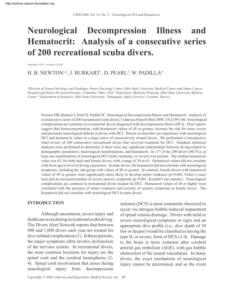

Authors: Rebekah M. Steele, Soren Brage, Kirsten Corder,
Nicholas J. Wareham, and Ulf Ekelund
The metabolic syndrome, marked by multiple
cardiovascular and diabetes risk factors, is rising in adults
and now also in children and adolescents. This review
examines recent evidence on the relationship between
physical activity, cardiorespiratory fitness (CRF), and
metabolic risk in youth. Findings suggest that physical
activity and CRF are independently associated with
metabolic risk factors in young people. Further research is
needed to determine the amount of physical activity
required to prevent metabolic syndrome.


Authors:
Claudio Marabotti, Alessandro Scalzini, Danilo Cialoni,
Mirko Passera, Antonio L’Abbate, and Remo Bedini
This study evaluated the cardiovascular response to body
immersion and increased environmental pressure during
diving in 12 healthy male subjects. Using two-dimensional
Doppler echocardiography, the subjects were assessed in
five conditions: out of the water, head-out immersion
while breathing, fully immersed at the surface while
breathing, breath-holding, and breath-hold diving at a 5-
meter depth. Key measurements included heart rate, left
ventricular volumes, stroke volume, cardiac output, and
left ventricular diastolic function indexes.
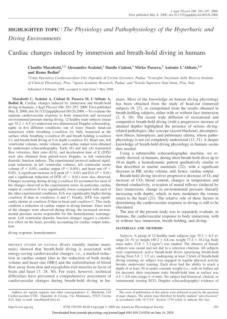

Author: Martin DJ Sayer, Jim Akroyd and Guy D Williams
The intent of this paper is to provide an analysis and
discussion of wreck diving activities at Bikini Atoll, focusing
on the frequency and nature of decompression dives, the
incidence of decompression illness among divers, and the
factors contributing to differences in illness rates between
customer divers and dive guides. The text aims to
highlight the physiological reasons behind the varying
rates of decompression illness and reviews these rates
across different diving populations.
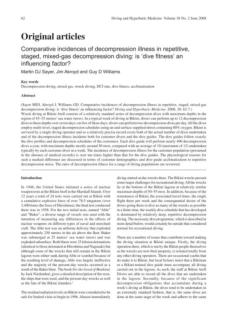

Authors:
Si Jack Chong, Teck Wei Tan and Jordan Yu Jin Lim
This document presents the findings of a retrospective
study analyzing the lung function of Republic of
Singapore Navy (RSN) divers over a five-year period. The
study aims to determine whether there has been any
deterioration in lung function among these divers by
comparing spirometric results from 2001 and 2006. The
results indicate statistically significant improvements in
certain lung function parameters, suggesting no decline
in lung function over the period studied.


Author: Neal W Pollock
This paper provides an overview of breath-hold diving,
including its historical context, the evolution of
performance records, the requirements for competitive
performance, and the importance of safety practices. The
text aims to inform readers about the current state of
breath-hold diving, strategies to optimize performance,
and recommendations for safe participation in the activity.


The Divers Alert Network (DAN) was founded in 1980,
with its headquarters located at Duke University Medical
Centre in Durham, North Carolina, USA. The organization
is dedicated to promoting dive safety worldwide through
research, medical services, education, and emergency
support for divers including professional divers.
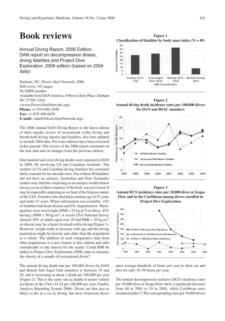

Authors: T Breskovic, P Denoble, I Palada, A Obad, Z Valic,
D Glavas, D Bakovic, and Z Dujic
This paper evaluates and compares the formation of
venous gas bubbles and the risk of decompression
sickness (DCS) in individuals with chronic spinal cord injury
(SCI) and able-bodied diving instructors (C) following
open-sea scuba dives. The study aims to assess the safety
of the diving profile used by monitoring gas bubbles and
estimating the probability of DCS using a decompression
model. The results indicate that the diving profile is safe for
both groups, as no signs of DCS were developed and the
severity of exposure was within the typical range for
recreational dives.
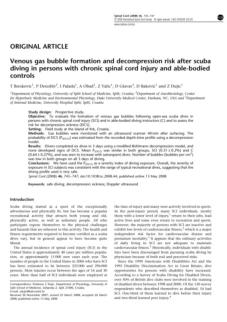

Authors:
Yasushi Suwazono, Mirei Dochi, Kouichi Sakata, Yasushi
Okubo, Mitsuhiro Oishi, Kumihiko Tanaka, Etsuko
Kobayashi, Teruhiko Kido & Koji Nogawa
This document presents the findings of a longitudinal
cohort study that investigated the association between
job schedules (day work vs. alternating shift work) and
weight gain, measured by increases in BMI, among male
Japanese workers in a steel company. The study found
that alternating shift work is an independent risk factor for
weight gain. The text also suggests that efficient health
screening, regular checkups, and support to control
unhealthy lifestyle factors could benefit the health of
Japanese shift workers.
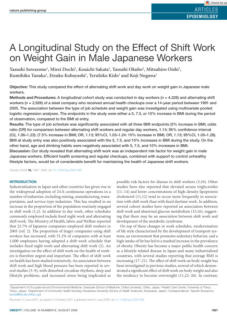

Authors: Simon J. Mitchell & David J. Doolette
This study aims to present a scientific hypothesis and
supporting evidence regarding the selective vulnerability
of the inner ear to decompression sickness in divers with
right-to-left shunts. The text explains the discrepancy
between the presence of arterial bubbles and the
frequent absence of cerebral symptoms by suggesting
that slower inert gas washout from the inner ear after
diving leads to prolonged supersaturation, making the
inner ear more susceptible to decompression sickness. The
text uses published models to predict tissue gas tensions
and supports the hypothesis with these predictions.
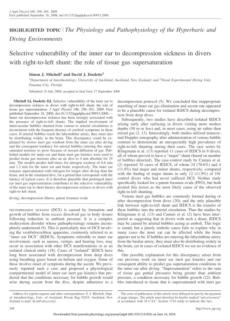

Authors: Barry W. Allen, Ivan T. Demchenko, and Claude
A. Piantadosi
This document reviews and discusses recent research
findings on the roles of reactive oxygen and nitrogen
species, particularly nitric oxide (NO), in both causing and
defending against oxygen toxicity. The text aims to
highlight the mechanisms of toxicity and protection in
hyperoxia, the influence of NO's anatomical localization,
and the potential for future pharmacological
interventions. Additionally, it seeks to provide insights into
the pathogenesis of central nervous system oxygen
toxicity and pulmonary oxygen toxicity, which could have
broader implications for understanding related medical
conditions.
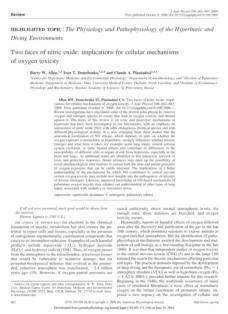

Author: Jorge D. Erusalimsky
The authors of this document aim to provide an overview
and analysis of cellular senescence, particularly in the
context of vascular endothelium. Therefore, the
document presents evidence of senescence in vascular
endothelial cells, discusses the mechanisms and factors
that influence endothelial cell replicative capacity and the
onset of senescence, and examines the characteristics of
the senescent phenotype and its potential implications for
the development and progression of vascular diseases.
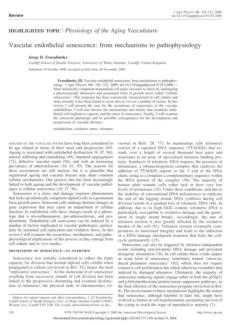

Authors: Yoram Etzion, Amir Mor, & Yoram Grossman
It is claimed that performing a “deep stop,” a stop at about
half of the maximal diving depth (MDD), can reduce the
amount of detectable precordial bubbles after the dive
and may thus diminish the risk of decompression sickness.
In order to ascertain whether this reduction is caused by
the deep stop or by a prolonged decompression time, the
team wanted to test the “deep stop” theory without
increasing the total decompression time.
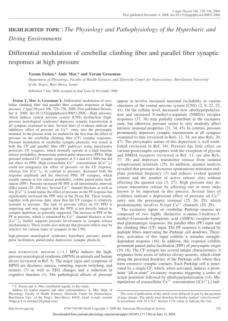

Authors: D.R. Pendergast, & C.E.G. Lundgren
The intent of the text is to provide a detailed scientific
explanation of the physiological effects of immersion in
water on the human body. It discusses how immersion
impacts various bodily systems, including the
cardiovascular, endocrine, and renal systems, and
describes the changes in blood flow, cardiac output, and
respiratory function. The text also addresses how different
factors such as water depth and temperature influence
these physiological responses, particularly in the context of
exercise performance.
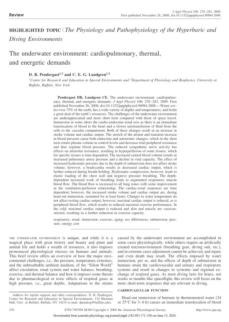

Author: Michael Knauth
Whether recreational diving can cause brain lesions
and/or neuropsychological impairment has been the
subject of several studies, but an unequivocal consensus
opinion has not yet been established. This article reviews
research on structural brain changes and
neuropsychological testing in divers and focuses on
recreational diving.


Authors:
T.P. van Rees Vellinga, W. Sterk, A.G.E.M. de Boer, A.J. van
der Beek, A.C. Verhoeven, F.J.H. van Dijk
The authors of this paper present and evaluate the
findings of a study comparing two deep-diving
techniques, bounce dive and saturation-excursion, using
Doppler ultrasound surveillance in the context of the
Western Scheldt Tunneling Project, to determine the
effectiveness and safety of these techniques, particularly in
terms of bubble formation and decompression incidents.
They conclude that the saturation-excursion technique is
preferable for deep and long exposures in caisson work.
They also suggest the incorporation of Doppler
ultrasound in future compressed-air work for monitoring
purposes.




14 - Acute ischemic colitis during scuba diving: Report of a unique
case
- Published by the World Journal of Gastroenterology (Author-released)

Authors: Konstantinos Goumas, Androniki Poulou,
Ioannis Tyrmpas, Dimitrios Dandakis, Stavros
Bartzokis, Magdalini Tsamouri, Kalipso Barbati,
Dimitrios Soutos
The presentation of symptoms from decompression
during diving can vary, often showing minor
gastrointestinal issues. This case discusses whether diving
can lead to severe gastrointestinal symptoms. A 27-year-
old man experienced abdominal pain and bloody
diarrhea after ascending from a dive at 20 meters. Medical
evaluations showed no other factors for colon ischemia,
suggesting a possible link between diving and ischemic
colitis. This case may indicate a hematologic reaction to
decompression sickness.
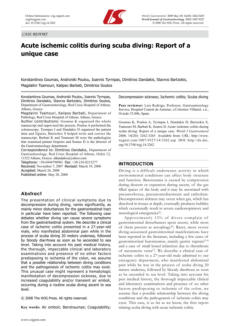



30 - Relation Between Right-to-Left Shunts and Spinal Cord
Decompression Sickness in Divers
- Published by the International Journal of Sport Medicine - Thieme
Author: Emmanuel Gemp, Jean Eric Blatteau, Eric
Stephan, Pierre Louge
This study investigates the role of right-to-left shunting
(RLS) in spinal cord decompression sickness (DCS) among
49 divers. It finds a higher prevalence of large RLS in DCS
divers compared to controls. RLS is linked to DCS,
especially with thoracolumbar involvement.
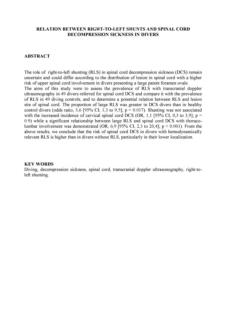




37 - Scuba Diving Increases Erythrocyte and Plasma Antioxidant
Defenses and Spares NO without Oxidative Damage.
- Published by the American College of Sports Medicine
Authors: Antoni Sureda, Miguel D. Ferrer, Joan M. Batle,
Pedro Tauler, Josep A. Tur , and Antoni Pons
This study aimed to examine the effects of a single deep
scuba dive on blood antioxidant defenses, cellular
damage, and nitric oxide production. Seven male divers
immersed at 40 m for 25 min. Blood samples were taken
before, immediately after, and 3 hours post-dive. Results
showed an increased antioxidant response in blood
without cellular damage and higher nitric oxide levels,
linked to its vasodilator function.


Author: Antonio Sureda, Miguel Ferrero, Joan Batle,
Pedro Tauler, Josep A. Tur, and Antonio Pons
The aim of this study was to investigate the effects of a
single scuba dive to a depth of 40 m on erythrocyte and
plasma antioxidant defenses, erythrocyte damage, and
nitric oxide (NO) production. Seven male preprofessional
divers completed a 25-minute dive. Blood samples were
taken before, immediately after, and 3 hours after diving.
The dive triggered an antioxidant response in plasma and
erythrocytes without causing cellular damage and
increased NO, linked to its role in vasodilation.


38 - Scuba Diving Increases Erythrocyte and Plasma Antioxidant
Defenses and Spares NO without Oxidative AQ1 Damage
Diving Increases Erythrocyte and Plasma Antioxidant Defenses
and Spare
- Published by the American College of Sports Medicine
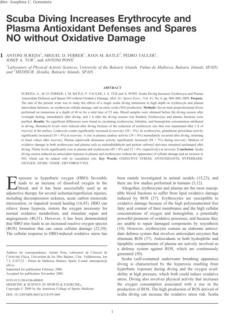



2 - Post effect of repetitive exposures to pressure nitrogen-induced
narcosis on the dopaminergic activity at atmospheric pressure
- Published by the Undersea & the Hypperbaric Medical Society (Author-released)

Authors: C. Lavoute, M. Weiss, JM Sainty, JJ Risso, JC
Rostain
Nitrogen narcosis is a neurological syndrome caused by
repetitive exposure to nitrogen pressure. A single
exposure to 3 MPa of nitrogen reduced dopamine
concentration by 20% in the striatum, affecting
extrapyramidal motor activity. This effect was explained
by enhanced GABAergic neurotransmission and
decreased glutamatergic input to DA cells through
NMDA receptors. This study investigated alterations of
NMDA receptor activity in the substantia nigra pars
compacta (SNc) induced by repetitive nitrogen
exposures. Results showed that NMDA could elevate
dopamine concentrations, but AP7 increased it.
